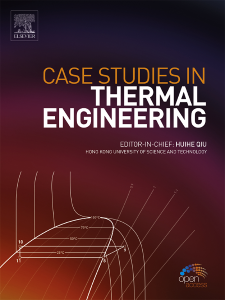Experimental investigation on the thermophysical properties and solidification characteristics of n-octadecane in a spherical capsule
IF 6.4
2区 工程技术
Q1 THERMODYNAMICS
引用次数: 0
Abstract
A thorough understanding of the thermophysical properties of phase change materials and the natural convection effect during the phase transition process is crucial for the accurate modeling and designing latent heat storage systems. However, research findings on the thermophysical properties of n-octadecane and the natural convection effect during the solidification process remain insufficient. In this study, the thermophysical properties of n-octadecane, including latent heat, thermal conductivity, density, thermal expansion coefficient and dynamic viscosity, were systematically measured under varying temperature conditions. Subsequently, a comprehensive solidification experiment of n-octadecane in a spherical capsule was conducted to assess the temporal and spatial temperature distribution characteristics and the evolution patterns of the solidification front. Finally, numerical techniques were employed to quantify the impact of natural convection. The results indicate that, the relationship between solidification mass fraction and time follows a quartic polynomial pattern. Based on the temperature curve at the central point, the solidification process of n-octadecane can be divided into four distinct stages. The first two stages account for 98.2 % of the total heat release, with natural convection primarily concentrated in the sensible heat release stage of liquid phase, contributing only 2.3 % to the entire solidification process, making its effect essentially negligible.
正十八烷在球形胶囊中的热物理性质和凝固特性的实验研究
全面了解相变材料的热物理性质以及相变过程中的自然对流效应对于准确建模和设计潜热储存系统至关重要。然而,有关正十八烷的热物理性质和凝固过程中的自然对流效应的研究成果仍然不足。本研究系统地测量了正十八烷在不同温度条件下的热物理性质,包括潜热、热导率、密度、热膨胀系数和动态粘度。随后,进行了正十八烷在球形胶囊中的全面凝固实验,以评估凝固前沿的时空温度分布特征和演变模式。最后,采用数值技术量化了自然对流的影响。结果表明,凝固质量分数与时间之间的关系遵循四次多项式模式。根据中心点的温度曲线,正十八烷的凝固过程可分为四个不同的阶段。前两个阶段释放的热量占总释放热量的 98.2%,自然对流主要集中在液相的显热释放阶段,对整个凝固过程的贡献仅为 2.3%,其作用基本上可以忽略不计。
本文章由计算机程序翻译,如有差异,请以英文原文为准。
求助全文
约1分钟内获得全文
求助全文
来源期刊

Case Studies in Thermal Engineering
Chemical Engineering-Fluid Flow and Transfer Processes
CiteScore
8.60
自引率
11.80%
发文量
812
审稿时长
76 days
期刊介绍:
Case Studies in Thermal Engineering provides a forum for the rapid publication of short, structured Case Studies in Thermal Engineering and related Short Communications. It provides an essential compendium of case studies for researchers and practitioners in the field of thermal engineering and others who are interested in aspects of thermal engineering cases that could affect other engineering processes. The journal not only publishes new and novel case studies, but also provides a forum for the publication of high quality descriptions of classic thermal engineering problems. The scope of the journal includes case studies of thermal engineering problems in components, devices and systems using existing experimental and numerical techniques in the areas of mechanical, aerospace, chemical, medical, thermal management for electronics, heat exchangers, regeneration, solar thermal energy, thermal storage, building energy conservation, and power generation. Case studies of thermal problems in other areas will also be considered.
 求助内容:
求助内容: 应助结果提醒方式:
应助结果提醒方式:


